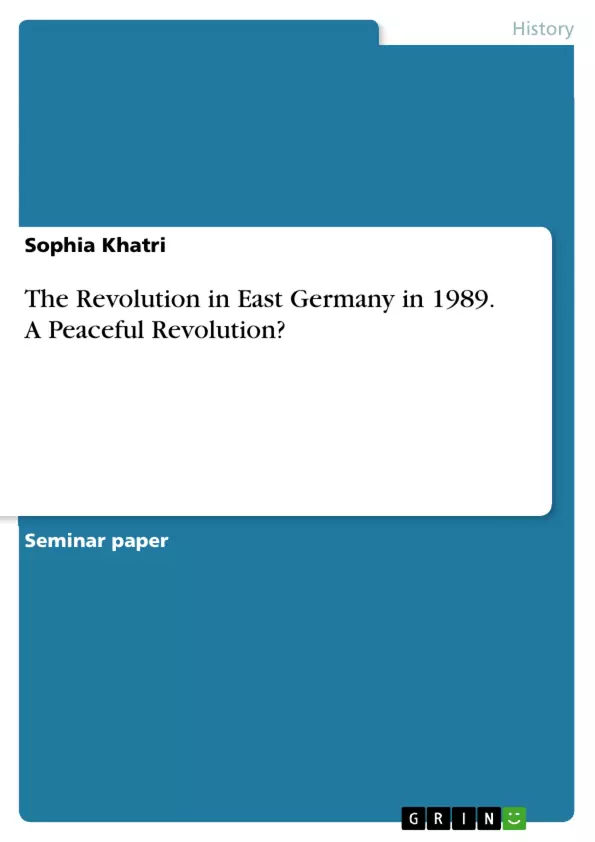This paper discusses the classic understanding of the Revolution in East Germany in 1989. The excluding criteria of violence will be challenged upon the revolutionary process. Furthermore, the reasons for the non-violent participation in the protest will be analysed upon a structural-behavioural approach within the Ration Action Theory. This paper examines the term 'Peaceful Revolution' and its outstanding characteristic of peaceful. First, the definition and framework of the Revolution will be discussed. The paper concentrates on the non-violent aspect through a behavioural-rational approach which will be also introduced to the reader.
In the second part, the paper will discuss if the process in East-Germany fulfils the conditions of a Revolution. Furthermore, the reasons why people participated in demonstrations in the autumn of 1989, especially why the people choose a non-violent way, will be viewed. The paper follows the research question: Why did the protest in Autumn 1989 in East Germany remain peaceful? How does the Peaceful Revolution challenge the classic definition of Revolution?
1989 became a historically important year for Germany and the whole of Europe: The fall of the Wall on November 9th became a symbol for the self-liberation of East Germans. It marked the end of an authoritarian soviet Era and the reunification of one of the economically strongest nations in Europe. Today 30 years later the Peaceful Revolution is celebrated as a unique spontaneous and non-violent revolution in Germany.
The GDR (German Democratic Republic) citizens reached for freedom during the Monday demonstrations in the main cities of Leipzig, Dresden, and East-Berlin after they were oppressed for 40 years by a socialist totalitarian regime. Elementary human rights such as freedom of travel, speech, and information were taken away from them. During one month, October 1989, East Germans started writing history: the dictatorship was peacefully challenged with demonstrations and rallies and then completely swept away. Divided Germany and Europe were gone. October 9th is seen as a milestone in Germany's road to freedom and finally resulted in the Fall of the Wall on November 9th.
Inhaltsverzeichnis (Table of Contents)
- Abstract
- Introduction
- Definition of Revolution
- Change
- Forcible (violent) change
- Mass mobilization
- Rational Action Theory
- Analysis of Revolution in East Germany 1989
- Reasons for the non-violent character of the Peaceful Revolution
- Conclusion
- Bibliography
- Appendix
- Interview 1
- Interview 2
- Interview 3
Zielsetzung und Themenschwerpunkte (Objectives and Key Themes)
This paper explores the classic understanding of the Revolution and challenges the excluding criteria of violence in relation to the revolutionary process in East Germany in October 1989. It analyzes the reasons for non-violent participation in the protest, drawing on a structural-behavioral approach within the Rational Action Theory. The analysis concludes that non-violent protests were the most effective, morally accepted, and less provoking strategy for GDR citizens, influenced by both behavioral and structural factors. The paper aims to understand the interplay between the people and the political elite in the decision to refrain from violence.
- Peaceful Revolution
- Non-violent Protest
- Rational Action Theory
- Mass Mobilization
- Human Rights
Zusammenfassung der Kapitel (Chapter Summaries)
The paper begins by introducing the historical context of the Peaceful Revolution in East Germany in 1989, highlighting the significance of the fall of the Berlin Wall and the reunification of Germany. It then delves into the definition of revolution, exploring different theoretical perspectives and the role of mass mobilization, institutional change, and violent action. The paper presents a nuanced understanding of revolution, acknowledging both violent and non-violent forms. The chapter on the Rational Action Theory provides a theoretical framework for analyzing individual actions and the motivations behind participation in social movements. The final chapter focuses on the specific case of East Germany in 1989, examining the reasons for the non-violent nature of the revolution and the interplay between the people and the political elite.
Schlüsselwörter (Keywords)
This paper revolves around the core concepts of peaceful revolution, non-violent protest, human rights, and the application of Rational Action Theory to understand the complexities of social movements. The analysis focuses on the role of mass mobilization and individual agency in driving change, while exploring the historical context of the German reunification in 1989.
- Quote paper
- Sophia Khatri (Author), 2020, The Revolution in East Germany in 1989. A Peaceful Revolution?, Munich, GRIN Verlag, https://www.grin.com/document/997575



